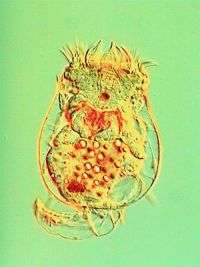Hidden interactions between predators and prey: evolution causes cryptic dynamics in ecology

When the populations of two species oscillate together (for example, predators and prey), it’s a good bet that they are tightly coupled ecologically. A famous example is the Canadian lynx and snowshoe hare, documented in the trapping records of the Hudson’s Bay Company. But is the opposite also true" If the prey’s population doesn’t fluctuate while the predator’s does, can we assume they are not tightly linked in the food web?
Among ecologists, this has generally been thought to be the case. But in a new multidisciplinary study published this week in the open-access journal PLoS Biology, Takehito Yoshida from the University of Tokyo in Japan and colleagues from the Universities of Cornell, Oregon, and Michigan in the USA have come together to show that cryptic evolutionary dynamics can link these populations.
The authors observed the dynamics of a rotifer and its food source, a unicellular alga, in a laboratory microcosm (in this case, a chemostat with an aqueous growth chamber whose nutrient supply is kept steady through a continuous in-and-out flow of medium). They were therefore able to experimentally manipulate the conditions of the two species. Under many different conditions, the pair co-oscillated and was tightly linked, just like the lynx and the hare. Yet, sometimes the rotifer’s population waxed and waned, while the algal population abundance remained virtually constant.
Yoshida and colleagues demonstrate mathematically that this could occur when the algal population comprises more than one genotype: one type more palatable to the rotifer predator and one less so. Needing direct data to back up this finding, the researchers then turned to another pair of interacting species in a laboratory microcosm, the bacterium Escherichia coli and the phage virus T4. Despite wide swings in phage abundance, they maintained a constant bacterial population by including vulnerable and resistant strains of the bacteria. Importantly, the population of the vulnerable bacterial strain showed a typical predator-prey cycle with the phage.
The researchers call this pattern of predator–prey population changes “cryptic dynamics,” because the rapid evolution of the prey into different genotypes masks the strong interaction between the two species. The implications of this prediction for understanding natural communities are extensive: observations of predator and prey population dynamics cannot always be trusted to be informative about the strength or even the existence of interspecific trophic links because such cryptic evolutionary dynamics may occur in a large fraction of trophic interactions.
Citation: Yoshida T, Ellner SP, Jones LE, Bohannan BJM, Lenski RE, et al. (2007) Cryptic population dynamics: Rapid evolution masks trophic interactions. PLoS Biol 5(9): e235. doi:10.1371/journal.pbio.0050235.
Source: Public Library of Science
















